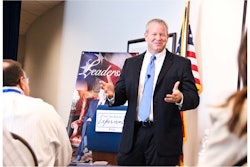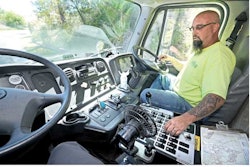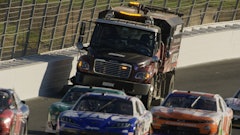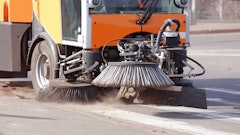With a new year and a new president, many in the construction industry are feeling optimistic about what the year has in store. The sweeping industry, by extension, is hoping this optimism grows and an industry riddled by regulations can continue to gain some ground.
With three decades in the industry, Ranger Kidwell-Ross, Executive Director of the World Sweeping Association (WSA) feels that while the sweeping industry may be gaining momentum, there are extreme challenges in the pipeline that need to be addressed first.
Contract Sweeping Setbacks
The sweeping industry is still dealing with cutbacks in frequency, price pressure and property management woes. Due to this, the contract sweeping industry is faced with some heavy hitting issues.
“In the parking lot sweeping realm, cutbacks in sweeping frequency, price pressures and third-party vendor pricing are all everyday impacts, but the current move toward risk transfer to sweeping contractors, especially, has created an inordinate problem,” Kidwell-Ross says. “Insurance premiums have risen dramatically, as insurers are increasingly required to hire several different attorneys in order to represent sweeping companies that have signed contracts putting them into a first liability situation.”
Kidwell-Ross says that in most instances, contractors sign the agreements they are given without knowing the risks.
“Many smaller sweeping contractors, especially, both need the work and are not sophisticated enough to know what clauses to remove,” Kidwell-Ross says. “Others figure ‘it won’t happen to me.’ As a result, contractors end up being in first position in lawsuits that involve things like slip-and-falls even when such may have occurred days after they last swept a property. As you might imagine, this has a serious impact on policy costs.”
Kidwell says the WSA is helping to tackle this issue by initiating discussions with insurance providers and third-party vendors, as well as providing information to members about contract clauses they should review with their business council.
Another area the WSA has been addressing is the movement by general contractors to include “omissions liability” in contracts offered to subcontractors, including sweeping companies.
“These largely open-ended clauses make sweeping companies liable for — in addition to the usual liability for acts they might perform incorrectly, or “co-omissions” — something they did not do but the general contractor decided they should have done, or should have done better,” Kidwell says. “For example, if the contractor’s sweeper breaks down on a milling job and an immediate backup sweeper is not standing by and available onsite, the contractor could be charged for the cost of all employees on the site who have been idled; the cost of cooling asphalt in dump trucks; the cost of not finishing the job within the allocated time period, etc.”
These types of clauses have become routine in some marketplaces and sweeping contractors are signing them without realizing the implications.
“This is especially problematic given that WSA research indicates that general liability and other insurance a sweeping contractor might have does not cover those types of omissions clauses.”
Regulation Scares
Construction sweeping is usually not hit as hard by pricing regulations due to the fact that frequency is often mandated by state and federal environmental agency stormwater runoff considerations, but that could change.
“Under the incoming Trump Administration, it is widely expected that the power of the EPA will be curtailed, if not eliminated entirely,” Kidwell says. “This would potentially have a seriously negative impact on the use of sweepers for construction activities, as well as putting downward pressure on the use of sweepers in the many municipalities where additional sweeping is currently being done in order to increase compliance with Stormwater Phase I and II requirements.”
For example, the City of Seattle doubled its sweeping for fiscal year 2016 in an attempt to reduce runoff materials into Puget Sound. If the requirements to reduce runoff were eliminated it is entirely possible that would not have occurred.
Another regulation that will impact the sweeping industry is the OSHA Silica Dust Ruling and how to monitor sweeper operators so that their level of exposure is within the personal exposure limits (PEL) set. However, Kidwell-Ross says the Trump Administration could overturn this ruling in 2017.
“There is little question that — especially for construction sweeping applications — sweeper operators may well experience dust limits in excess of the rule,” Kidwell-Ross says. “I am advising members to take a wait-and-see approach, since this new OSHA rule is one that also has a likelihood of being overturned by the incoming Trump Administration.
“If left in place, the new silica dust rule has the possibility of impacting the power sweeping industry in an extreme fashion. In the event the OSHA rule is not struck down, I foresee the manufacturing community moving toward providing chassis with positively pressurized cab environments.”
Fortunately, Kidwell-Ross says it appears that sweeping contractors will not be liable for potential dust exposure by their clients’ employees on the ground at a job site they’re sweeping.
Rising Costs
When manufacturers have to respond to regulations, those costs are immediately passed on to sweeping companies.
“The complaint I hear most from contractors concerns the cost of new sweepers,” Kidwell-Ross says. “Especially on the parking lot sweeping side of the industry, it is increasingly difficult to obtain customer pricing that justifies the purchase of today’s new sweepers. For that reason, I believe an increasing number of contractors are refurbishing their older units, often putting the sweeper body onto a different chassis.
“There is also a general reluctance to use Tier 4 engines as the reliability of the new Tier 4 engine in the sweeping application is extremely poor. Because the sweeping industry is relatively small, and is one of the few that tends to run vehicles at a slow speed for long periods of time, it appears that the testing protocol for the new DEF requirements did not take slow-moving vehicles into account. Contractors across the country have reported difficulties with regeneration and/or having their chassis put into “limp mode” and not knowing what to do about it.”
Kidwell-Ross says that the WSA is always open to communicate with sweeping companies about issues they are facing in 2017.




![Pavement Awards 2025[main]](https://img.forconstructionpros.com/files/base/acbm/fcp/image/2024/05/PavementAwards_2025_main_.665883e4276e8.png?auto=format%2Ccompress&bg=fff&fill-color=fff&fit=fill&h=100&q=70&w=100)







![Pavement Awards 2025[main]](https://img.forconstructionpros.com/files/base/acbm/fcp/image/2024/05/PavementAwards_2025_main_.665883e4276e8.png?ar=16%3A9&auto=format%2Ccompress&bg=fff&fill-color=fff&fit=fill&h=135&q=70&w=240)







